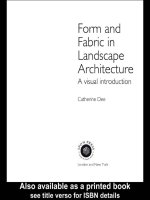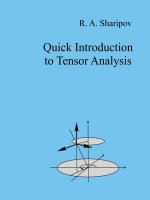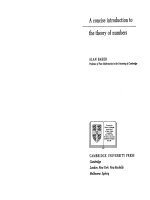- Trang chủ >>
- Khoa Học Tự Nhiên >>
- Vật lý
nagarjunas madhyamaka a philosophical introduction feb 2009
Bạn đang xem bản rút gọn của tài liệu. Xem và tải ngay bản đầy đủ của tài liệu tại đây (939.02 KB, 257 trang )
Nāgārjuna’s Madhyamaka
This page intentionally left blank
Nāgārjuna’s
Madhyamaka
A Philosophical Introduction
jan westerhoff
1
2009
3
Oxford University Press, Inc., publishes works that further
Oxford University’s objective of excellence
in research, scholarship, and education.
Oxford New York
Auckland Cape Town Dar es Salaam Hong Kong Karachi
Kuala Lumpur Madrid Melbourne Mexico City Nairobi
New Delhi Shanghai Taipei Toronto
With offices in
Argentina Austria Brazil Chile Czech Republic France Greece
Guatemala Hungary Italy Japan Poland Portugal Singapore
South Korea Switzerland Thailand Turkey Ukraine Vietnam
Copyright © 2009 by Oxford University Press, Inc.
Published by Oxford University Press, Inc.
198 Madison Avenue, New York, New York 10016
www.oup.com
Oxford is a registered trademark of Oxford University Press
All rights reserved. No part of this publication may be reproduced,
stored in a retrieval system, or transmitted, in any form or by any means,
electronic, mechanical, photocopying, recording, or otherwise,
without the prior permission of Oxford University Press.
Library of Congress Cataloging-in-Publication Data
Westerhoff, Jan.
Nagarjuna’s Madhyamaka: a philosophical introduction / Jan Westerhoff.
p. cm.
Includes bibliographical references.
ISBN 978-0-19-537521-3; 978-0-19-538496-3 (pbk.)
1. Nagarjuna, 2nd cent. 2. Madhyamika (Buddhism) I. Title.
BQ7479.8.N347W48 2008
294.3'92092—dc22 2008024577
9 8 7 6 5 4 3 2 1
Printed in the United States of America
on acid-free paper
to
DSR
“Don’t you mind dying, sir?” the consul asked. “Forgive me a little
lofty talk,” van Gulik said, “but all movement is illusory. From Seoul to
Kobe. From life to death.”
Janwillem van de Wetering, Robert van Gulik: His Life, His Work
Acknowledgments
This book owes many different things to many different people. My
greatest debt of gratitude is to David Seyfort Ruegg, who spent many
hours with me talking through various incarnations of these pages
and generously shared his encyclopedic knowledge of the Indian and
Tibetan philosophical traditions. Ulrich Pagel provided invaluable
support in academic as well as in administrative matters.
On the linguistic side I have to thank Alexandra Leduc for organ-
izing a splendid Sanskrit-Tibetan translation seminar in London
(despite only narrowly avoiding appeal to the rule tres faciunt colle-
gium), as well as Ulrike Roesler for attempting to arrange something
similar at Oxford. Mattia Salvini acted as a guide to the perplexed
concerning various points of Sanskrit grammar and, apart from
being an excellent Sanskritist, showed himself to be a similarly excel-
lent thinker and provided me with many very useful suggestions for
understanding Nāgārjuna’s arguments. Geshe Sherab Gyatso kindly
offered his help in trying to make sense of a rather terse passage in a
Tibetan commentary on Nāgārjuna.
Jay Garfield and Tom Tillemans read through previous versions
of this material and made many useful suggestions which helped me
to improve the discussion considerably. Ralf Kramer, former Tibetan
librarian at the Indian Institute in Oxford, tracked down the most
obscure texts in the shortest possible time and gave me countless
fascinating Tibetological references. Support in various forms was
provided by the Spalding Trust, the Society for South Asian Studies, and the
Deutsche Forschungsgemeinschaft and is gratefully acknowledged.
Finally, thanks are due to Yuka Kobayashi for keeping the sun shining.
J.C.W.
New York City
First day of the Male Earth
Rat Year of the 17th Cycle
viii acknowledgments
Contents
Abbreviations, xi
1. Introduction, 3
1.1 Nāgārjuna the Philosopher, 4
1.2 Nāgārjuna‘s Works, 5
1.3 Methodological Considerations, 6
1.4 The Philosophical Study of Nāgārjuna in the West, 9
1.5 Overview, 12
2. Interpretations of Svabhāva, 19
2.1 The Ontological Dimension, 20
2.2 The Cognitive Dimension, 46
3. The Role of Negation in Nāgārjuna’s Arguments, 53
3.1 Nyāya Theory of Negation, 54
3.2 Negation and Nondenoting Terms, 56
3.3 Negation and Temporal Relations, 64
4. The Catus
.
kot
.
i or Tetralemma, 67
4.1 Two Kinds of Negation, 68
4.2 Rejection of Two Alternatives, 70
4.3 Rejection of Four Alternatives, 73
4.4 Affirming Four Alternatives: The Positive Tetralemma, 89
5. Causation, 91
5.1 Causation: Preliminary Remarks, 92
5.2 Interdependence of Cause and Effect, 94
5.3 The Four Ways of Causal Production, 99
5.4 Temporal Relations between Cause and Effect, 113
5.5 Analysis of Time, 124
6. Motion, 129
6.1 Arguments Concerning Motion, 130
6.2 The Beginning of Motion, 142
6.3 The Interdependence of Mover and Motion, 147
6.4 The Second Chapter of the MMK in Its Argumentative Context, 150
7. The Self, 153
7. 1 The Self and Its Parts, 154
7.2 The Self and Its Properties, 158
7.3 Epistemology of the Self, 160
7.4 The Madhyamaka View of the Self, 162
8. Epistemology, 165
8.1 Means of Knowledge as Self-established, 167
8.2 Means of Knowledge and Their Objects as Mutually Established, 173
8.3 Temporal Relations between Means and Objects of Knowledge, 177
8.4 The Aim of Nāgārjuna’s Arguments, 179
9. Language, 183
9.1 Nāgārjuna’s View of Language and the “No-Thesis” View, 183
9.2 VV 29 in Context, 184
9.3 The Semantic Interpretation, 188
9.4 The Specific Role of Verse 29, 194
1 0. Conclusion: Nāgārjuna’s Philosophical Project, 199
10.1 Metaphysics, 199
10.2 Personal Identity, 208
10.3 Ethics, 212
10.4 Epistemology, 216
10.5 Language and Truth, 219
Bibliography, 225
Index, 239
x contents
Abbreviations
References to works in verse give the number of the chapter and
verse or half-verse (e.g., MMK 24:18, RĀ 1:49a), apart from works
not usually subdivided into chapters, such as the YS
.
, ŚS, VV, and
VP, where only the number of the verse is given. References to
works in prose give the page and line of the editions cited below
(e.g. VV(S) 82:3–7).
works by nāgārjuna
MMK Mūlamadhyamakakārikā
J.W. De Jong, Christian Lindtner (eds.), Nāgārjuna’s
Mūlamadhyamakakārikā Prajn˜ā Nāma. Adyar Library,
Adyar, Chennai, 2004.
YS
.
Yuktis
.
as
.
t
.
ikā
Cristina Anna Scherrer-Schaub: Yuktis
.
as
.
t
.
ikāvr
.
tti: Commentaire
`a la soixantaine sur le raisonnement, ou, du vrai enseignement
de la causalité. Institut belge des hautes études chinoises,
Brussels, 1991.
ŚS Śūnyatāsaptati
“The Śūnyatāsaptati of Nāgārjuna,” chapter 3 of Fernando Tola
and Carmen Dragonetti, On Voidness. A Study of Buddhist
Nihilism, Motilal Banarsidass, Delhi, 2002, 53–99.
VV Vigrahavyāvartanī
VV(S) Svavr
.
tti on the Vigrahavyāvartanī
Kamaleswar Bhattacharya, E. H. Johnston, and Arnold Kunst (eds.),
The Dialectical Method of Nāgārjuna. Motilal Banarsidass, Delhi, 1998.
VP Vaidalyaprakaran
.
a
VP(S) Svavr
.
tti on the Vaidalyaprakaran
.
a
Fernando Tola and Carmen Dragonetti, Nāgārjuna’s Refutation of Logic.
Motilal Banarsidass, Delhi, 1995.
RĀ Ratnāvalī
Michael Hahn: Nāgārjuna’s Ratnāvalī. The Basic Texts (Sanskrit,
Tibetan, Chinese). Indica et Tibetica, Bonn, 1982.
works by other authors
PP Candrakīrti’s Prasannapadā
Louis de la Vallée Poussin (ed.), Prasannapadā Mūlamadhyamakavr
.
ttih
.
.
Bibliotheca Buddhica IV, St Petersburg, 1903–1913.
J. W. De Jong: “Textcritical notes on the Prasannapadā,” Indo-Iranian
Journal 20, 1978, 25–59, 217–252. (Corrections of the above edition.)
MA Candrakīrti’s Madhyamakāvatāra
MAB Candrakīrti’s Madhyamakāvatārabhās
.
ya
Louis de la Vallée Poussin (ed.), Madhyamakāvatāra par Candrakīrti
Bibliotheca Buddhica IX, St. Petersburg, 1907–1912.
CŚ Āryadeva’s Catuh
.
śataka
Karen Lang (ed.), Āryadeva’s Catuh
.
śataka. On the Bodhisattva’s Cultivation
of Merit and Knowledge. Akademisk Forlag, Copenhagen, 1986.
BCA Śāntideva’s Bodhicaryāvatāra
Louis de la Vallée Poussin (ed.), Bodhicaryāvatāra of Çāntideva,
Asiatic Society of Bengal, Calcutta, 1907.
xii abbreviations
NS Nyāyasūtra
Taranatha Nyaya-Tarkatirtha and Amarendramohan Tarkatirtha (eds.),
Nyāyadarśanam with Vātsyāyana’s Bhās
.
ya, Uddyotakara’s Vārtika,
Vācaspati Miśra’s Tātparyat
.
īkā and Viśvanātha’s Vr
.
tti, Munshiram
Manoharlal, Delhi, 1985.
abbreviations xiii
This page intentionally left blank
Nāgārjuna’s Madhyamaka
This page intentionally left blank
1
Introduction
The following pages contain an investigation of Nāgārjuna’s philo-
sophy from a systematic perspective. Considering Nāgārjuna’s impor-
tant place in Buddhist philosophy as well as in Indian thought more
generally, it is not surprising that his works have given rise to an enor-
mous number of commentaries, studies, and analyses in Asia, and,
more recently, also in the West. A large amount of these take the form
of commentaries on specific texts, following their structure and analyz-
ing individual passages in considerable detail. While the importance
and usefulness of such commentaries is beyond dispute, the present
work sets out to approach Nāgārjuna’s philosophy from a different
perspective. The idea is to present a synoptic overview of Nāgārjuna’s
arguments concerning different philosophical problems in order to
present an account of the whole of his philosophy, showing how its in-
dividual parts fit together as elements of a single philosophical project.
In order to achieve this goal, it is not sufficient to give a mere para-
phrase of Nāgārjuna’s arguments (as is frequently found in the sec-
ondary literature). We will have to analyze their philosophical contents,
examine actual as well as possible objections, determine whether the
arguments can in fact be made to work, and, if so, what kind of philo-
sophical conclusion they support. Comparatively little work has been
done in this direction. Since a great part of the contemporary Western
studies of Nāgārjuna are interested primarily in philological, historical,
or religious aspects of his works, genuinely philosophical studies have
been rare. The aim of the present study is to help close this gap.
4 nāgārjuna’s madhyamaka
The following pages should be of interest both to philosophers looking
for a systematic account of Nāgārjuna’s philosophical position, and to Indolo-
gists and scholars of Buddhist studies interested primarily in the philosophical
aspects of Nāgārjuna’s works. To make this material as accessible as possible
to readers with little or no background in Indian philosophy, I generally use
English equivalents of technical Indian philosophical terms (such as “object”
for dharma, “emptiness” for śūnyatā, “primary existence” for dravyasat, and so
forth), providing the Sanskrit term in brackets if necessary. The only case where
I have systematically violated this policy concerns the term svabhāva. My rea-
son is that there is no single term used in Western philosophy that covers the
different aspects of its meaning in the Madhyamaka context in a satisfactory
manner. But given that all of chapter 2 is dedicated to a discussion of how we
are to understand the notion of svabhāva, the reader should have a sufficiently
clear conception of its meaning when encountering it again in later chapters.
For the benefit of Indologists and Buddhist scholars, the Sanskrit and Tibetan
(and occasional Pali) of all quotations is given in the footnotes. Some material
and references in the footnotes will be particularly relevant to philosophers,
some are of more historical or philological interest. I have made no attempt
to differentiate the “philosophical” and “Indological” footnotes but trust in the
reader’s discernment to find the material that interests him.
Different kinds of readers might prefer different routes through the material
presented here. Those interested in a step-by-step introduction to Nāgārjuna’s
philosophy should read the chapters in numerical order. Readers with previous
acquaintance with Madhyamaka material who are interested in what I have to
say on a particular Nāgārjunian topic will prefer to go directly to the relevant
chapter. For those wanting to get straight at the philosophical content, I rec-
ommend finishing the introduction, followed by chapter 2, then immediately
jumping to chapter 10. Then it is possible to dip into any of chapters 3 to 9 for
more specific discussion of topics one finds interesting.
1.1. Nāgārjuna the Philosopher
Nāgārjuna, one of the greatest thinkers in the history of Asian philosophy, re-
mains an enigma. Despite the existence of various legendary accounts of his
life passed down in Buddhist literature,
1
contemporary scholars agree on hardly
any details concerning him. It is unclear when he lived (although some time
1. Walleser (1923); Dowman (1985).
introduction 5
during the first three centuries a.d. is most likely),
2
where he worked (almost
all places in India have been suggested),
3
what he wrote (the Tibetan canon at-
tributes 116 different texts of very diverse content and quality to him), and even
how many Nāgārjunas there were in the first place (up to four different ones
have been distinguished).
4
Recent research by Joseph Walser suggests that Nāgārjuna may have written
the Ratnāvalī sometime between 170 and 200 a.d. in the area around present-
day Amarāvatī.
5
This conclusion is based on two facts. First, there is a variety of
evidence connecting Nāgārjuna with the Sātavāhana dynasty.
6
This is not very
helpful on its own, since this dynasty spanned several centuries. However, in
verse 232 of the Ratnāvali, Nāgārjuna mentions a depiction of the Buddha sit-
ting on a lotus ( padmapīt
.
ha). Given that such images were available only during
the late part of the dynasty in the Eastern Deccan, Walser comes to the tentative
conclusion that Nāgārjuna composed the text during the reign of king Yajn˜a Śrī
Sātakarn
.
i (about 175 to 204 a.d.).
7
Of course none of this can be regarded as hard
evidence, especially as the necessary detour via art history (in order to find the
earliest date for the type of depictions of the Buddha Nāgārjuna describes) intro-
duces a whole new range of complexities and uncertainties. Nevertheless, given
our present inability to find out the time and place of Nāgārjuna in any other way,
determining them approximately on the basis of a variety of historical data such
as suggested by Walser is surely to be preferred to not determining them at all.
1.2. Nāgārjuna’s Works
Assuming we resolve the uncertainty about Nāgārjuna’s time and place by lo-
cating him in the second century a.d. in the Eastern Deccan, how do we deal
with the multitude of works ascribed to him? This investigation will be based
primarily on six of Nāgārjuna’s works:
1. The “Fundamental Verses on the Middle Way”
(Mūlamadhyamakakārikā, MMK)
2. The “Sixty Stanzas on Reasoning” (Yuktis
.
as
.
t
.
ikā, YS
.
)
2. Mabbett (1998: 332). For an extensive list of references see Ruegg (1981: 4–6, n. 11).
3. Walser (2005: 67).
4. The most common view distinguishes only three Nāgārjunas: the Madhyamaka philosopher, the tantric
adept, who possibly flourished around 400 a.d.(Lindtner 1982: 11, n. 12), and the alchemist, who might be placed
in the seventh century (Walser 2005: 69, 75–79), (Eliade 1969: 415–416). For criticism of the thesis of multiple
Nāgārjunas see Hua (1970).
5. Walser (2005: 61).
6. Walser (2005: 293, n. 26).
7. Walser (2005: 86).
6 nāgārjuna’s madhyamaka
3. The “Seventy Stanzas on Emptiness” (Śūnyatāsaptati, ŚS)
4. The “Dispeller of Objections” (Vigrahavyāvartanī, VV)
5. The “Treatise on Pulverization” (Vaidalyaprakaran
.
a, VP)
6. The “Precious Garland” (Ratnāvalī, RĀ)
This set, the so-called Yukti-corpus, is well known in the Tibetan tradi-
tion, where is it called the “collection of the six texts on reasoning” (rigs pa’i
tshogs drug).
8
We cannot be certain that all six texts were indeed composed by
Nāgārjuna; apart from the MMK, where Nāgārjuna’s authorship is taken to
be true by definition, the attribution of every other one has been questioned.
9
However, apart from the fact that all these texts were attributed to Nāgārjuna
by a variety of Indian
10
and Tibetan Madhyamaka authors, they also expound a
single, coherent philosophical system. For the purposes of this discussion we
will therefore identify Nāgārjuna with the author of the Yukti-corpus.
1.3. Methodological Considerations
The six texts under consideration are all written in verse. In some cases they are
accompanied by an autocommentary in prose, though the status of these au-
tocommentaries is not always unproblematic.
11
Since this inquiry is intended
to be a study of Nāgārjuna’s Madhyamaka, the texts of the Yukti-corpus con-
stitute the basis of our discussion. It is nevertheless not possible to provide
a philosophically satisfactory exposition of Nāgārjuna’s thought based exclu-
sively on these texts. This is because their versified form often leads to a very
condensed expression of arguments which requires a variety of details to be
filled in. In itself this is hardly surprising given that Indian philosophical texts
(unlike their Western counterparts) were generally not intended to provide the
reader with a self-contained exposition of the author’s thoughts. Instead their
versified form provided the structure of the argument to be memorized, which
8. See, e.g., Bu ston’s History of Buddhism (Obermiller 1931: I, 50–51).
9. Warder (1973: 79) notes that the authorship of Nāgārjuna for texts other than the MMK “has not been
established beyond doubt and we ought not to assume it.” For comments on the authorship of the YS
.
see Tola
and Dragonetti (1995a: 19–20), for the ŚS see Tola and Dragonetti (1995a: 54–55). The attribution of the VV is
questioned in Tola and Dragonetti (1998) (but see Ruegg [2000: 115, n. 10]), that of the VP in Tola and Dragonetti
(1995b: 7–15) and Pind (2001). For the RĀ see Walser (2005: 271–278).
10. Including Bhāviveka, Candrakīrti, Śāntaraks
.
ita, and Kamalaśīla. See Lindtner (1982: 10–11, n. 9).
11. Despite substantial Indian support, the autocommentary on the MMK, the Akutobhayā, is not regarded
as genuine by contemporary researchers (Lindtner [1982: 15–16, n. 33), but see Walleser (1911: iv]). The autocom-
mentary on the ŚS is regarded as authentic by Lindtner (1982: 31), but Tola and Dragonetti (1995a: 57–58) dis-
agree. There seems to be no dispute about the authenticity of the autocommentaries on the VV and VP.
introduction 7
would then be elaborated on by written commentaries and by a teacher’s oral
explanations. The reader of Nāgārjuna’s works will frequently encounter pas-
sages in which Nāgārjuna asserts that a certain position is deficient and ought
not to be accepted, without giving the reason why this is the case.
In order to give an assessment of the philosophical argument presented,
such gaps have to be closed. Sometimes this can be done in a straightforward
manner by consideration of other passages in Nāgārjuna’s works where simi-
lar issues are discussed. In other cases matters are more difficult. Occasionally
Nāgārjuna’s extant works do not provide information about how a certain argu-
ment is to be understood, and so we face an important methodological issue. How
do we justify ascribing a certain argument to Nāgārjuna if there is no evidence
of such an argument being made in his works that have come down to us?
The commentarial literature is of great help in dealing with this issue. We
find a long and voluminous tradition of commentaries on Nāgārjuna’s works
in India, Tibet, and China spanning nearly two millennia. These commen-
taries often unpack the complexity of Nāgārjuna’s compact verses by adding
invaluable information about terminology, philosophical content, and alterna-
tive interpretations. So even though all of Nāgārjuna’s own texts might be silent
on how to spell out a particular argument, commentaries will often provide us
with information in this regard. Since these are part of a long argumentative
tradition of considerable sophistication, some of which arose in relatively close
proximity to Nāgārjuna’s own intellectual context, they should be taken very se-
riously when interpreting his thoughts. Our first methodological maxim when
“filling in” the missing parts of Nāgārjuna’s arguments should therefore be to
attempt consistency with the commentarial tradition.
The situation we are faced with might be compared to that of a restorer
who wants to reconstruct parts of a painting that have been destroyed. In order
to determine how to fill in the missing bits, he will do well to consider descrip-
tions of the painting from the time when it was still intact, as well as copies,
sketches, and drawings by other artists which have been based on the work in
question. The restorer will then have a good idea of what might have been de-
picted on the missing piece of the canvas and can go about reconstructing it.
A difficulty we face is that while Nāgārjuna’s works sometimes give not
enough information, the commentarial tradition often presents us with more
than we want. Like traditions in general, that of commentaries on Nāgārjuna
does not speak with one voice. Some of the more obscure passages are read in
so many different ways that we might despair about ever being able to come up
with a faithful reconstruction of Nāgārjuna’s arguments.
Suppose one of the sources the restorer consults tells him that the missing
lower left corner of the painting depicted a dog, another says that it depicted
8 nāgārjuna’s madhyamaka
a wolf, and a sketch shows a peacock in that same place. He might now try
to rule out some of these variant interpretations on stylistic or iconographical
grounds, but the conclusion arrived at must necessarily be highly conjectural.
Fortunately, the restorer of philosophical arguments is in a slightly better
position, because the parts of a philosophical text hang together in a way that
the parts of a painting do not, since they form part of a coherent philosophical
argument and express a unified philosophical position. At least this is what we
have to assume if we want to adopt a charitable interpretation of the texts in
question. Doing so seems to be a precondition for accomplishing any kind of
philosophical reconstruction at all.
12
It of course does not imply that we as-
sume the author is always right, but rather that we read his texts in a way that
maximizes the rationality of the material. We might in the end find flaws in
the argument or have other reasons for rejecting the conclusions, but doing so
presupposes assuming that arguments and conclusion are to be found there in
the first place.
Based on the necessity of providing a charitable interpretation, we can
therefore use a second methodological maxim, namely to reconstruct an argu-
ment in the philosophically most successful way. Faced with a variety of interpre-
tations in the commentarial literature, we can systematically select those that
make most sense in presenting Nāgārjuna’s philosophy as a systematic whole,
as an intellectual enterprise whose parts fit together to present a unified philo-
sophical theory.
Of course the extent to which the following discussion satisfies the above
maxims may be disputed: different views on what the commentarial literature
says and on which kinds of arguments are more successful do exist, and it is
useful to compare these to gain a good grasp of the purpose of Nāgārjuna’s
arguments. What I hope will be clear, however, is that the interpretation of
Nāgārjuna’s thought presented here is not arbitrary but has been arrived at in
an attempt to find the best balance between the two maxims of doctrinal coher-
ence and systematic success.
Although the presentation of Nāgārjuna’s philosophical positions given
here, unlike that found in some contemporary literature,
13
is very much in ac-
cordance with the mainstream of Indian and Tibetan commentarial literature,
its main aim is not to present a historical description of Nāgārjuna’s views
but rather to present Nāgārjuna’s thought in a way that brings out its system-
atic appeal. There is a tendency in some parts of Buddhist studies to undersell
12. For the notion of the “principle of charity” see Davidson (1973).
13. Such as Wood (1994) or Burton (1999).
introduction 9
Nāgārjuna’s thoughts by giving a purely descriptive and paraphrasing account
of his arguments, which frequently falls short on philosophical sophistication.
The present work is intended to redress the balance to some extent by showing
the importance and impact of Nāgārjuna’s thoughts as philosophy.
1.4. The Philosophical Study of Nāgārjuna in the West
Western interest in Nāgārjuna as a philosopher is a comparatively recent phe-
nomenon, going back little more than a century.
14
In itself this attention con-
stitutes only a part of Nāgārjunian scholarship, a substantial portion of which
concerns itself with problems of philology, textual history, or the study of re-
ligion. A concise overview of the specifically philosophical investigation of
Nāgārjuna in the West has been presented by Andrew Tuck.
15
Tuck argues that
its history can be divided into three phases, corresponding to three Western
philosophical frameworks against which Nāgārjuna used to be interpreted. First
is the Kantian phase, then the analytic phase, and finally a post- Wittgensteinian
one.
16
A clear example from the first phase is Theodore Stcherbatsky’s The Con-
ception of Buddhist Nirvān
.
a, which was first published in 1927.
17
Stcherbatsky
interprets Nāgārjuna as dividing the world into appearance and reality, the
former corresponding to sam
.
sāra, the realm of cyclic existence, the latter to
nirvān
.
a, liberation. In his attempt to defend Nāgārjuna against the charge of
nihilism, especially clear in the exposition given by La Vallée Poussin,
18
Stcher-
batsky ascribes to Nāgārjuna the assumption of an absolute noumenal reality
which underlies the constantly changing and ephemeral world of phenomena.
The further development of this Kantianization of Nāgārjuna is presented in
what is still a basic text of Buddhist studies, T. R. V. Murti’s 1955 The Central
Philosophy of Buddhism.
19
Since Murti’s exposition of Nāgārjuna is considerably
more detailed than Stcherbatsky’s, the fundamental difficulties of interpreting
Nāgārjuna according to a Kantian framework become more readily apparent.
Murti observes that “the relation between the two [i.e., the Absolute and the
14. The earliest systematic Western treatment of Madhyamaka more generally is to be found in the works
of the Jesuit missionary Ippolito Desideri (1684–1733). Desideri published a number of works in Tibetan in which
he attempted a refutation of Tibetan Buddhism from the perspective of Roman Catholicism. See Desideri (1981–
1989).
15. (1990).
16. (1990: 16–30).
17. Stcherbatsky (1968).
18. (1908: 101).
19. “The position occupied by the Mādhyamika in Indian philosophy is similar to that of Kant in modern
European philosophy [. . .].” (Murti 1955: 123).
10 nāgārjuna’s madhyamaka
world of phenomena] is not made abundantly clear. This may be said to consti-
tute a drawback in the Mādhyamika conception of the Absolute.”
20
On the other
hand, we might want to argue that the reason for this “drawback” is a defect
not in the Madhyamaka position but in the choice of interpretative framework.
To conceive of Nāgārjuna’s Madhyamaka as a theory whereby an indescribable
Absolute grounds the world of appearances means reading assumptions into it
that Nāgārjuna does not share, thereby resulting in an unsatisfactory theory.
The second, analytic phase of Western studies of Nāgārjuna can be re-
garded as starting shortly after the publication of Murti’s book, with Richard
Robinson’s 1957 article “Some Logical Aspects of Nāgārjuna’s System.”
21
Robin-
son sets out to analyze some of Nāgārjuna’s arguments using the resources
of modern symbolic logic, the ultimate aim being “to transcribe the Kārikās
entirely, chapter by chapter, into logical notation, thus bringing to light formal
features which do not appear from the consideration of examples taken out of
context and listed topically.”
22
The shift from the Kantian to the analytic read-
ing of Nāgārjuna which Robinson’s paper inaugurates brings with it a shift in
the aspects of his thought receiving most attention. The focus is shifted from
an investigation of the primarily metaphysical problem of the relation between
sam
.
sāra and nirvān
.
a to the logical aspects of Nāgārjuna’s thought: his use of
quantification and negation as well as the mechanics of the notorious form of
argument known as the “tetralemma” (catus
.
kot
.
i ).
If one considers the bigger picture, however, once again the limitations of
the reading of Nāgārjuna during the analytical phase become apparent. Many
of his views, concerning, for example, the rejection of a foundationalist ontol-
ogy or the difficulties of assuming a world conforming to the structure of the
language we use to refer to it, contradict assumptions of analytic philosophy of
the first half of the twentieth century. While the employment of certain tools
that are dear to analytic philosophers could be seen as presenting Nāgārjuna’s
arguments more clearly, it was also evident that Nāgārjuna would have had lit-
tle regard for many of the goals aimed at by analytic philosophers. Neither the
attempt to develop a logically perfect language for describing the world nor to
ground our knowledge of the world on the supposedly secure foundation of
sense-data could find much favor with Mādhyamikas. Analytic philosophy with
its specific set of philosophical assumptions was helpful in trying to under-
stand Nāgārjuna, but only up to a point.
20. (1955: 237).
21. Robinson (1957).
22. (1957: 307).









